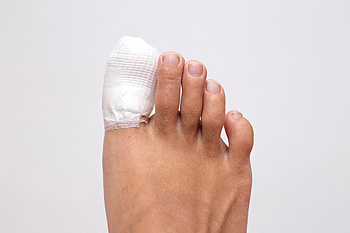 A common injury that many patients can endure is a broken toe. This can be the painful result of a heavy object falling on the toe, or from stubbing the toe against a piece of furniture. Common symptoms that are generally associated with a broken toe include severe pain, swelling, and bruising. If the fracture is severe, the bone may dislocate and protrude from the skin. If the toe is mildly broken, relief may be found by taping the affected toe to the toe next to it. This is referred to as buddy taping, and may provide the necessary stability as the healing process takes place. If you suspect that you have a broken toe, it is strongly recommended that you consult with a podiatrist who can offer you treatment options.
A common injury that many patients can endure is a broken toe. This can be the painful result of a heavy object falling on the toe, or from stubbing the toe against a piece of furniture. Common symptoms that are generally associated with a broken toe include severe pain, swelling, and bruising. If the fracture is severe, the bone may dislocate and protrude from the skin. If the toe is mildly broken, relief may be found by taping the affected toe to the toe next to it. This is referred to as buddy taping, and may provide the necessary stability as the healing process takes place. If you suspect that you have a broken toe, it is strongly recommended that you consult with a podiatrist who can offer you treatment options.
A broken toe can be very painful and lead to complications if not properly fixed. If you have any concerns about your feet, contact one of our podiatrists from Lovely Foot Associates, PC. Our doctors will treat your foot and ankle needs.
What to Know About a Broken Toe
Although most people try to avoid foot trauma such as banging, stubbing, or dropping heavy objects on their feet, the unfortunate fact is that it is a common occurrence. Given the fact that toes are positioned in front of the feet, they typically sustain the brunt of such trauma. When trauma occurs to a toe, the result can be a painful break (fracture).
Symptoms of a Broken Toe
Generally, it is best to stay off of the injured toe with the affected foot elevated.
Severe toe fractures may be treated with a splint, cast, and in some cases, minor surgery. Due to its position and the pressure it endures with daily activity, future complications can occur if the big toe is not properly treated.
If you have any questions please feel free to contact our office located in Johnstown, PA . We offer the newest diagnostic and treatment technologies for all your foot and ankle needs.
When it comes to heel pain, two common causes are heel spurs and plantar fasciitis. Heel spurs are bony growths that develop on the heel bone. They can irritate the tissues in the heel, causing pain and discomfort when you are standing or walking. Plantar fasciitis is the inflammation of the plantar fascia, a band of tissue that stretches along the bottom of the foot and connects the heel bone to the toes. Plantar fasciitis develops when the plantar fascia becomes overstretched or overused and causes sharp, stabbing heel pains. While heel spurs and plantar fasciitis have similar symptoms, the latter is much more likely to cause symptoms. In fact, heel spurs are often painless. However, the only true way to tell apart these two conditions is by having an X-ray taken. A podiatrist can examine your feet and diagnose and treat your condition.
Many people suffer from bouts of heel pain. For more information, contact one of our podiatrists of Lovely Foot Associates, PC. Our doctors can provide the care you need to keep you pain-free and on your feet.
Causes of Heel Pain
Heel pain is often associated with plantar fasciitis. The plantar fascia is a band of tissues that extends along the bottom of the foot. A rip or tear in this ligament can cause inflammation of the tissue.
Achilles tendonitis is another cause of heel pain. Inflammation of the Achilles tendon will cause pain from fractures and muscle tearing. Lack of flexibility is also another symptom.
Heel spurs are another cause of pain. When the tissues of the plantar fascia undergo a great deal of stress, it can lead to ligament separation from the heel bone, causing heel spurs.
Why Might Heel Pain Occur?
Treatments
Heel pain should be treated as soon as possible for immediate results. Keeping your feet in a stress-free environment will help. If you suffer from Achilles tendonitis or plantar fasciitis, applying ice will reduce the swelling. Stretching before an exercise like running will help the muscles. Using all these tips will help make heel pain a condition of the past.
If you have any questions please contact our office located in Johnstown, PA . We offer the newest diagnostic and treatment technologies for all your foot and ankle needs.
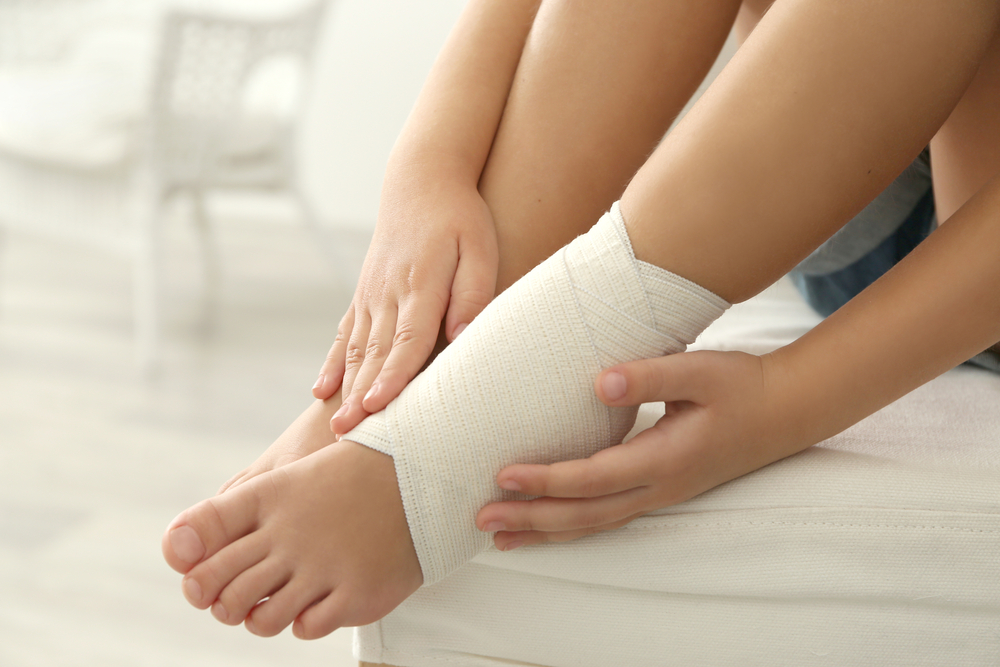 A common form of an ankle sprain is referred to as an inversion sprain. It can happen when the ankle abnormally turns in or out. This affects the lateral ligaments which are located on the outside of the ankle. Lateral ligaments are bands that help the joints to remain stable, and ankle sprains can result when these ligaments are overstretched. This type of injury can happen from suddenly stepping off a curb, wearing shoes that do not fit correctly, or from walking on uneven surfaces. Effective treatment methods can consist of wearing a protective boot or brace, and performing specific stretches that may accelerate the healing process. If you have sprained your ankle, it is strongly recommended that you seek the counsel of a podiatrist who can guide you toward appropriate treatment options.
A common form of an ankle sprain is referred to as an inversion sprain. It can happen when the ankle abnormally turns in or out. This affects the lateral ligaments which are located on the outside of the ankle. Lateral ligaments are bands that help the joints to remain stable, and ankle sprains can result when these ligaments are overstretched. This type of injury can happen from suddenly stepping off a curb, wearing shoes that do not fit correctly, or from walking on uneven surfaces. Effective treatment methods can consist of wearing a protective boot or brace, and performing specific stretches that may accelerate the healing process. If you have sprained your ankle, it is strongly recommended that you seek the counsel of a podiatrist who can guide you toward appropriate treatment options.
Although ankle sprains are common, they aren’t always minor injuries. If you need your ankle injury looked at, contact one of our podiatrists from Lovely Foot Associates, PC. Our doctors can provide the care you need to keep you pain-free and on your feet.
How Does an Ankle Sprain Occur?
Ankle sprains are the result of a tear in the ligaments within the ankle. These injuries may happen when you make a rapid shifting movement while your foot is planted. A less common way to sprain your ankle is when your ankle rolls inward while your foot turns outward.
What Are the Symptoms?
Preventing a Sprain
Treatment of a Sprain
In many cases, the RICE method (Rest, Ice, Compression, and Elevate) is used to treat ankle sprains. However, you should see a podiatrist to see which treatment option would work best with your injury. In severe cases, surgery may be required.
It is important to ask your doctor about rehab options after you receive treatment for your injury. Stretching, strength training, and balance exercises may help the ankle heal while also preventing further injury.
If you have any questions, please feel free to contact our office located in Johnstown, PA . We offer the newest diagnostic and treatment technologies for all your foot care needs.
The Achilles tendon is a band of tissue that connects the muscles in your calf to your heel. The Achilles tendon endures a lot of stress and pressure during daily activities and exercise. Sometimes, the stress and pressure may become excessive, leading to an injury. Achilles tendonitis refers to an inflammation of the Achilles tendon. It typically stems from overuse and can cause symptoms such as pain and swelling. There are two types of Achilles tendonitis, insertional and noninsertional. In insertional tendonitis, the damage to the tendon occurs where the tendon meets the heel bone. Insertional tendonitis can occur at any age, both in active and in sedentary people, and is often associated with the development of bone spurs. Non-insertional Achilles tendonitis occurs when small tears in the middle fibers of the tendon start to break down. Non-insertional tendonitis typically affects young, active people. If you experience an injury to the Achilles tendon, it is recommended that you seek the care of a podiatrist.
Achilles tendon injuries need immediate attention to avoid future complications. If you have any concerns, contact one of our podiatrists of Lovely Foot Associates, PC. Our doctors can provide the care you need to keep you pain-free and on your feet.
What Is the Achilles Tendon?
The Achilles tendon is a tendon that connects the lower leg muscles and calf to the heel of the foot. It is the strongest tendon in the human body and is essential for making movement possible. Because this tendon is such an integral part of the body, any injuries to it can create immense difficulties and should immediately be presented to a doctor.
What Are the Symptoms of an Achilles Tendon Injury?
There are various types of injuries that can affect the Achilles tendon. The two most common injuries are Achilles tendinitis and ruptures of the tendon.
Achilles Tendinitis Symptoms
Rupture Symptoms
Treatment and Prevention
Achilles tendon injuries are diagnosed by a thorough physical evaluation, which can include an MRI. Treatment involves rest, physical therapy, and in some cases, surgery. However, various preventative measures can be taken to avoid these injuries, such as:
If you have any questions please feel free to contact our office located in Johnstown, PA . We offer the newest diagnostic tools and technology to treat your foot and ankle needs.
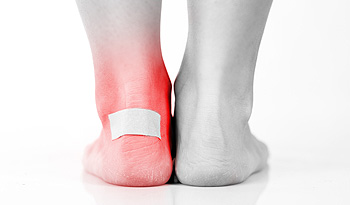 A blister is a fluid-filled bump that often appears on the foot. Most blisters are the result of excessive friction over a concentrated area of the foot, and are usually not serious. Left alone, they can typically heal without medical intervention. However, sometimes blisters can warrant a visit to the podiatrist. If you have a blister that you think may be infected, it is recommended that you see a doctor as soon as possible, as this can lead to a contagious bacterial infection of the skin, called secondary impetigo, or further complications like cellulitis or sepsis. You should also consult with a podiatrist if your blister is very painful or frequently recurs. For more information about foot blisters, speak with a podiatrist today.
A blister is a fluid-filled bump that often appears on the foot. Most blisters are the result of excessive friction over a concentrated area of the foot, and are usually not serious. Left alone, they can typically heal without medical intervention. However, sometimes blisters can warrant a visit to the podiatrist. If you have a blister that you think may be infected, it is recommended that you see a doctor as soon as possible, as this can lead to a contagious bacterial infection of the skin, called secondary impetigo, or further complications like cellulitis or sepsis. You should also consult with a podiatrist if your blister is very painful or frequently recurs. For more information about foot blisters, speak with a podiatrist today.
Blisters are prone to making everyday activities extremely uncomfortable. If your feet are hurting, contact one of our podiatrists of Lovely Foot Associates, PC. Our doctors can provide the care you need to keep you pain-free and on your feet.
Foot Blisters
Foot blisters develop as a result of constantly wearing tight or ill-fitting footwear. This happens due to the constant rubbing from the shoe, which can often lead to pain.
What Are Foot Blisters?
A foot blister is a small fluid-filled pocket that forms on the upper-most layer of the skin. Blisters are filled with clear fluid and can lead to blood drainage or pus if the area becomes infected.
How Do Blisters Form?
Blisters on the feet are often the result of constant friction of skin and material, usually by shoe rubbing. Walking in sandals, boots, or shoes that don’t fit properly for long periods of time can result in a blister. Having consistent foot moisture and humidity can easily lead to blister formation.
Prevention & Treatment
It is important to properly care for the affected area in order to prevent infection and ease the pain. Do not lance the blister and use a Band-Aid to provide pain relief. Also, be sure to keep your feet dry and wear proper fitting shoes. If you see blood or pus in a blister, seek assistance from a podiatrist.
If you have any questions, please feel free to contact our office located in Johnstown, PA . We offer the newest diagnostic and treatment technologies for all your foot care needs.
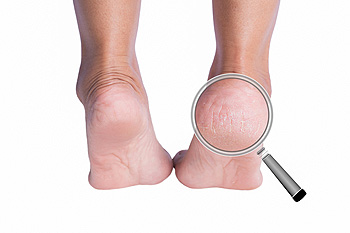 As the colder months approach, you may find that your heels are becoming increasingly dry and cracked. Fortunately, there are many things that can be done to help. Soaking your feet in a lukewarm oatmeal bath for about 20 minutes and then applying a moisturizer to the feet may help, as can soaking your feet in an Epsom salt bath. You can prevent dry, cracked heels by wearing appropriate footwear and protecting your feet from extremely hot or cold weather. When bathing, avoid exposing your feet to extremely hot water as well. When you wash your feet, choose a soap that doesn’t contain sodium lauryl sulfate or artificial fragrances, as these ingredients can often dry out the feet. If your dry heels persist, or if you develop deep, painful cracks, is it strongly suggested that you visit a podiatrist for treatment.
As the colder months approach, you may find that your heels are becoming increasingly dry and cracked. Fortunately, there are many things that can be done to help. Soaking your feet in a lukewarm oatmeal bath for about 20 minutes and then applying a moisturizer to the feet may help, as can soaking your feet in an Epsom salt bath. You can prevent dry, cracked heels by wearing appropriate footwear and protecting your feet from extremely hot or cold weather. When bathing, avoid exposing your feet to extremely hot water as well. When you wash your feet, choose a soap that doesn’t contain sodium lauryl sulfate or artificial fragrances, as these ingredients can often dry out the feet. If your dry heels persist, or if you develop deep, painful cracks, is it strongly suggested that you visit a podiatrist for treatment.
Cracked heels are unsightly and can cause further damage to your shoes and feet. If you have any concerns, contact one of our podiatrists from Lovely Foot Associates, PC. Our doctors can provide the care you need to keep you pain-free and on your feet.
Cracked Heels
Cracked heels appear unappealing and can make it harder for you walk around in sandals. Aside from looking unpleasant, cracked heels can also tear stockings, socks, and wear out your shoes. There are several methods to help restore a cracked heel and prevent further damage.
How Do You Get Them?
Dry skin is the number one culprit in creating cracked heels. Many athletes, walkers, joggers, and even swimmers suffer from cracked heels. Age and skin oil production play a role to getting cracked heels as well.
Promote Healing
Over the counter medicines can help, especially for those that need instant relief or who suffer from chronic dry feet.
Wear Socks – Wearing socks with medicated creams helps lock in moisture.
Moisturizers – Applying both day and night will help alleviate dryness which causes cracking.
Pumice Stones – These exfoliate and remove dead skin, which allows for smoother moisturizer application and better absorption into the skin.
Change in Diet
Eating healthy with a well-balanced diet will give the skin a fresh and radiant look. Your body responds to the kinds of food you ingest. Omega-3 fatty acids and zinc supplements can also revitalize skin tissue.
Most importantly, seek professional help if unsure how to proceed in treating cracked heels. A podiatrist will help you with any questions or information needed.
If you have any questions, please feel free to contact our office located in Johnstown, PA . We offer the newest diagnostic and treatment technologies for all your foot care needs.
At some point throughout our lives, we have all likely experienced an injury to the toe, foot, or ankle. These types of injuries often occur while participating in sports or recreational activities, while doing work-related tasks, or simply while walking around. Injuries of the lower limbs are generally divided into two categories. Acute injuries are those that occur suddenly. Examples of this type of injury include bruises, puncture wounds, injuries to ligaments, injuries to tendons, sprains, strains, fractures, dislocations, and compartment syndrome. Overuse injuries are those caused by repetitive stress being placed on the joint or tissue. Examples of this type of injury include retrocalcaneal bursitis, Achilles tendinopathy, stress fractures, plantar fasciitis, and metatarsalgia. If you have injured your toe, foot, or ankle, it is suggested that you see a podiatrist for diagnosis and treatment.
Foot and ankle trauma is common among athletes and the elderly. If you have concerns that you may have experienced trauma to the foot and ankle, consult with one of our podiatrists from Lovely Foot Associates, PC. Our doctors will assess your condition and provide you with quality foot and ankle treatment.
Foot and ankle trauma cover a range of injuries all over the foot; common injuries include:
Symptoms
Symptoms of foot and ankle injuries vary depending on the injury, but more common ones include:
Diagnosis
To properly diagnose the exact type of injury, podiatrists will conduct a number of different tests. Some of these include sensation and visual tests, X-rays, and MRIs. Medical and family histories will also be taken into account.
Treatment
Once the injury has been diagnosed, the podiatrist can than offer the best treatment options for you. In less severe cases, rest and keeping pressure off the foot may be all that’s necessary. Orthotics, such as a specially made shoes, or immobilization devices, like splints or casts, may be deemed necessary. Finally, if the injury is severe enough, surgery may be necessary.
If you have any questions, please feel free to contact our office located in Johnstown, PA . We offer the newest diagnostic and treatment technologies for all your foot care needs.
 A sprain is an injury to a ligament, which is the tissue that connects bones to each other. When ligaments in the toe are stretched or torn, the toe is sprained. This usually happens because of trauma or hyperextension, like when you hit your toe on a piece of furniture. The symptoms of a sprained toe include pain in the affected toe, tenderness, swelling, bruising, trouble moving the toe, and joint instability. If a sprain is severe, you might even feel a pop or tear. If you believe that you have sprained your toe, it is recommended that you see a podiatrist for treatment.
A sprain is an injury to a ligament, which is the tissue that connects bones to each other. When ligaments in the toe are stretched or torn, the toe is sprained. This usually happens because of trauma or hyperextension, like when you hit your toe on a piece of furniture. The symptoms of a sprained toe include pain in the affected toe, tenderness, swelling, bruising, trouble moving the toe, and joint instability. If a sprain is severe, you might even feel a pop or tear. If you believe that you have sprained your toe, it is recommended that you see a podiatrist for treatment.
Foot Pain
Foot pain can be extremely painful and debilitating. If you have a foot pain, consult with one of our podiatrists from Lovely Foot Associates, PC. Our doctors will assess your condition and provide you with quality foot and ankle treatment.
Causes
Foot pain is a very broad condition that could be caused by one or more ailments. The most common include:
Diagnosis
To figure out the cause of foot pain, podiatrists utilize several different methods. This can range from simple visual inspections and sensation tests to X-rays and MRI scans. Prior medical history, family medical history, and any recent physical traumatic events will all be taken into consideration for a proper diagnosis.
Treatment
Treatment depends upon the cause of the foot pain. Whether it is resting, staying off the foot, or having surgery; podiatrists have a number of treatment options available for foot pain.
If you have any questions, please feel free to contact our office located in Johnstown, PA . We offer the newest diagnostic and treatment technologies for all your foot care needs.
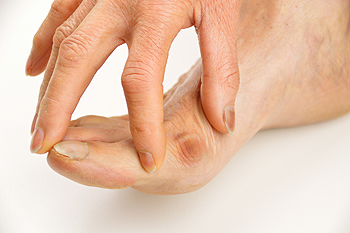 The medical condition that is referred to as arthritis may contribute to the development of bunions. Additionally, bunions can occur due to genetic factors, or from wearing shoes that do not have enough room for the toes to move freely in. Bunions are defined as bony growths that form on the side of the big toe and can cause pain and discomfort. Mild relief may be found when a protective pad is worn over the bunion, and larger shoes may need to be purchased. An X-ray may be performed to determine the severity of the bunion, and if it is large, and affects daily activities, surgery may be necessary for permanent removal. If you have developed a bunion, please consult with a podiatrist who can determine what the best course of treatment is for you.
The medical condition that is referred to as arthritis may contribute to the development of bunions. Additionally, bunions can occur due to genetic factors, or from wearing shoes that do not have enough room for the toes to move freely in. Bunions are defined as bony growths that form on the side of the big toe and can cause pain and discomfort. Mild relief may be found when a protective pad is worn over the bunion, and larger shoes may need to be purchased. An X-ray may be performed to determine the severity of the bunion, and if it is large, and affects daily activities, surgery may be necessary for permanent removal. If you have developed a bunion, please consult with a podiatrist who can determine what the best course of treatment is for you.
If you are suffering from bunion pain, contact one of our podiatrists of Lovely Foot Associates, PC. Our doctors can provide the care you need to keep you pain-free and on your feet.
What Is a Bunion?
Bunions are painful bony bumps that usually develop on the inside of the foot at the joint of the big toe. As the deformity increases over time, it may become painful to walk and wear shoes. Women are more likely to exacerbate existing bunions since they often wear tight, narrow shoes that shift their toes together. Bunion pain can be relieved by wearing wider shoes with enough room for the toes.
Causes
Symptoms
In order to diagnose your bunion, your podiatrist may ask about your medical history, symptoms, and general health. Your doctor might also order an x-ray to take a closer look at your feet. Nonsurgical treatment options include orthotics, padding, icing, changes in footwear, and medication. If nonsurgical treatments don’t alleviate your bunion pain, surgery may be necessary.
If you have any questions, please feel free to contact our office located in Johnstown, PA . We offer the newest diagnostic and treatment technologies for all your foot care needs.
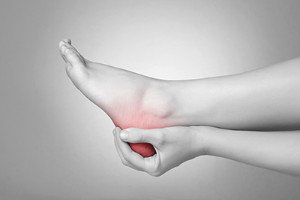 The medical condition that is known as Sever’s disease can affect young teenagers who frequently participate in running and jumping activities. A noticeable symptom of this condition is heel pain, and you may notice that your child is limping. Sever’s disease is caused by an inflammation on the growth plate in the heel, and can happen as a result of excessive pressure that the heels may endure from running or exercising. The heel may be swollen, and it may be difficult to walk. Moderate relief may come from wearing shoes that fit properly, and it may be beneficial to limit activity that is done on hard surfaces. If you feel your child may have Sever’s disease, it is recommended that you speak to a podiatrist who can properly diagnose and treat this condition.
The medical condition that is known as Sever’s disease can affect young teenagers who frequently participate in running and jumping activities. A noticeable symptom of this condition is heel pain, and you may notice that your child is limping. Sever’s disease is caused by an inflammation on the growth plate in the heel, and can happen as a result of excessive pressure that the heels may endure from running or exercising. The heel may be swollen, and it may be difficult to walk. Moderate relief may come from wearing shoes that fit properly, and it may be beneficial to limit activity that is done on hard surfaces. If you feel your child may have Sever’s disease, it is recommended that you speak to a podiatrist who can properly diagnose and treat this condition.
Sever's disease often occurs in children and teens. If your child is experiencing foot or ankle pain, see one of our podiatrists from Lovely Foot Associates, PC. Our doctors can treat your child’s foot and ankle needs.
Sever’s Disease
Sever’s disease is also known as calcaneal apophysitis, which is a medical condition that causes heel pain I none or both feet. The disease is known to affect children between the ages of 8 and 14.
Sever’s disease occurs when part of the child’s heel known as the growth plate (calcaneal epiphysis) is attached to the Achilles tendon. This area can suffer injury when the muscles and tendons of the growing foot do not keep pace with bone growth. Therefore, the constant pain which one experiences at the back of the heel will make the child unable to put any weight on the heel. The child is then forced to walk on their toes.
Symptoms
Acute pain – Pain associated with Sever’s disease is usually felt in the heel when the child engages in physical activity such as walking, jumping and or running.
Highly active – Children who are very active are among the most susceptible in experiencing Sever’s disease, because of the stress and tension placed on their feet.
If you have any questions, please feel free to contact our office located in Johnstown, PA . We offer the newest diagnostic and treatment technologies for all your foot and ankle injuries.